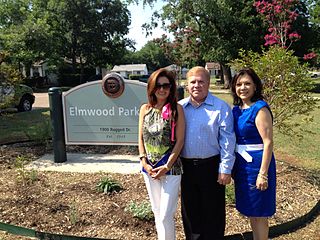
Dallas County is the second-most populous county in the U.S. state of Texas. As of the 2020 U.S. census, the population was 2,613,539, making it the ninth-most populous county in the country. Dallas County is included in the Dallas-Arlington-Fort Worth metropolitan statistical area—colloquially referred to as the Dallas–Fort Worth metroplex. Municipal expansion within Dallas County has blurred the geographic lines between cities and between neighboring counties.

Oak Cliff is an area of Dallas, Texas, United States that was formerly a separate town in Dallas County; Dallas annexed Oak Cliff on April 04, 1903. It has since retained a distinct neighborhood identity as one of Dallas' older established neighborhoods.
This article traces the history of Dallas, Texas,.

State Highway 183 is a state highway in the Dallas–Fort Worth metroplex in Texas. Its most heavily used section is designated Airport Freeway where it serves the southern entrance of Dallas–Fort Worth International Airport.

Loop 12 is a state highway that runs mostly within the city limits of Dallas, Texas. The western segment of the loop is named after General Walton Walker, who served and died in South Korea. During the 1950s and 1960s, Loop 12 was the outer beltway in the Dallas area, having since been supplanted by Interstate 635 (I-635), which is itself being supplanted by the President George Bush Turnpike. Loop 12 is, however, the only state highway in Dallas that forms a complete loop.
Winnetka Heights is one of the oldest and largest historical districts in the Oak Cliff section of Dallas, Texas (USA). The district is bounded by Davis Street on the north, 12th Street on the south, Willomet Avenue on the east and Rosemont Avenue on the west. Established in 1910, Winnetka Heights consists of early 20th century wood-frame houses.
South Oak Cliff High School is a public secondary school located in the Oak Cliff area of Dallas, Texas, United States. South Oak Cliff High School enrolls students in grades 9-12 and is a part of the Dallas Independent School District (DISD).

The Stemmons Corridor or Lower Stemmons is a stretch of industrial and commercial property in northwest Dallas, Texas (USA). From downtown north, Interstate 35E (I-35E) is known as the Stemmons Freeway, named so for Leslie Stemmons by his son, John M. Stemmons. It lies north of downtown, west of Oak Lawn, east of the Trinity River and Irving, and south of the Elm Fork of the Trinity River. The area has a considerable amount of hotels and office towers. Property in the district accounts for 20% of Dallas' tax base. I-35E in Dallas Texas is currently the widest freeway in the DFW area with 16 total lanes, 10 lanes of high speed freeway with 6 lanes of access roads, stretching from the Woodall Rodgers Expressway in Downtown Dallas to the State Highway 183 split. I-35E is one of the most congested freeways in the country.

The Convention Center District is an area in southern downtown Dallas, Texas (USA). It lies south of the Government District, north of the Cedars, west of the Farmers Market District, and east of the Reunion District. Visitdallas is contracted by the City to attract conventions, although an audit released in January 2019 cast doubts on its effectiveness.
This article is about transportation systems in and around Dallas, Texas (USA).

Kidd Springs is a neighborhood in the North Oak Cliff area of Dallas, Texas (USA). James Kidd purchased land in the area in the 1870s which included the spring now bearing his name.

King's Highway is located in the Oak Cliff area of Dallas, Texas (USA). The district is bounded by Stewart Drive on the north, Davis Street on the south, Tyler Street on the east and Mary Cliff Road on the west. It is in Dallas Council District 3.

Elmwood is a residential neighborhood in central Oak Cliff, within Dallas, Texas, composed of tudor cottages, craftsman bungalows and ranch-style homes built mostly in the 1920s through the 1950s surrounding a central greenbelt along the limestone banks of Cedar Creek (Texas).
The Redbird community of Dallas is a group of neighborhoods located in the southern Oak Cliff area of Dallas, Texas. This is a middle to upper middle class Neighborhood which includes Wynnewood Hills, Elderwoods/Elderoaks/Twin Oaks, and Glen Oaks.
Thomas Lafayette Marsalis was an American developer. With John S. Armstrong, the founder of Oak Cliff, he was one of the key developers of what is now known as the Dallas area.
Wynnewood is one of the main neighborhoods of Oak Cliff, the southwestern part of Dallas, Texas, United States. Wynnewood covers 820 acres (3.3 km2). The village was once known for buildings having old decorative wood flooring.

Uptown is a PID and a dense neighborhood in Dallas, Texas. Uptown is north of and adjacent to downtown Dallas, and is bordered by US 75 on the east, N Haskell Avenue on the northeast, the Katy Trail on the northwest, Bookhout Street and Cedar Springs Road on the west, N Akard Street on the southwest and Spur 366 on the south.

Downtown Dallas is the central business district (CBD) of Dallas, Texas, United States, located in the geographic center of the city. It is the second-largest business district in the state of Texas. The area termed "Downtown" has traditionally been defined as bounded by the downtown freeway loop, bounded on the east by I-345 (although known and signed as the northern terminus of I-45 and the southern terminus of US 75, on the west by I-35E, on the south by I-30, and on the north by Woodall Rodgers Freeway.
Kiest Park is a 263-acre (106 ha) park in southern Dallas, Texas, United States, established in 1931 by Edwin John Kiest, publisher of the Dallas Times Herald and a member of the Dallas Park Board in the 1930s who donated the land for the park. Named in memory of Kiest's late wife, artist Elizabeth Patterson Kiest, it is the largest City of Dallas Park in Oak Cliff and features hike-and-bike trails, tennis courts, baseball diamonds, playgrounds, picnic tables and several Works Progress Administration-era structures, including stone gates at three entrances to the park, a stone picnic shelter and a stone field house. The WPA also built a formal garden at the heart of Kiest Park. A pergola was built at the head of the garden in 1934 with WPA funds but fell into ruin and was cleared away. The nonprofit organization Friends of Oak Cliff Parks restored the historic garden and the City of Dallas rebuilt the pergola in 2014 based on the original plans, using $2 million in bond funds.














